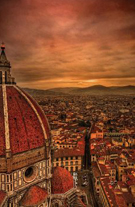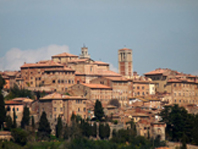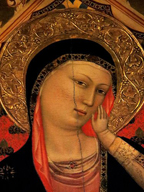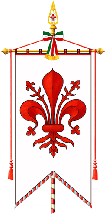|
Lauda: The lauds, or laude, were traditional religious songs collected in Cortona and Florence, Italy, in the 13th century. They were a simple and a sacred folk music of the people. These religious songs also reflected a desire of the craftsmen, merchants, and lay people (including women) to worship in a language they spoke every day. The single-line melodies were set to short rhymed lines, part local early Italian dialect (old Tuscan), and part church Latin. Originally, the lauda was a monophonic (single-voice) form, but a polyphonic type developed in the early fifteenth century. The word lauda comes from the Latin laudare (to praise). The early lauda was influenced by the music of the troubadours, as it shows similarities in rhythm, melodic style, and especially notation. Many troubadours had fled their original homelands, such as Provence, during the Albigensian Crusade in the early 13th century, and settled in northern Italy, where their music was influential in the development of the Italian secular style. Lauds were a sequence of religious songs, simple and naïve, after the praise songs, or lauds, of St. Francis of Assisi (1182–1226). The earliest collection of laude was Canticle of the Sun written by St. Francis in 1224 in Umbria, who in his youth was familiar and inspired by the work of the langue d’Oc poets (Italian and French troubadours). “St. Francis encouraged a combination of preaching and vernacular praise lyrics (Laudes Domini). . . .” They (the brothers) were to sing the praises of God as minstrels of the Lord” (Wilson, 1992). The laude are the oldest known collection of songs in the Italian vernacular and the only source of songs for the entire 13th century. They were collected and preserved in two cities—Florence (89 pieces) and Cortona (46 pieces). Lay confraternities (called laudesi) were formed to perform these laude at nonliturgical celebrations. They traveled around the country singing in a procession along the roads through the villages. They recounted the life of Christ from the Annunciation to the Pentecost. Included in the narrative were all the important scenes from the gospel— the Annunciation, the Nativity, the Praises of Mary Magdalene, the Kiss of Judas, the Climb to Calvary, the Resurrection, the Ascension, and the Pentecost. The laudesi often hired (and payed) professional musicians outside the company to perform on harps, lutes, portative organs, vielles (violins), and rebecs (small medieval violins). For special occasions such as feast days, trumpets, fifes, and drums were added to accompany the lauda singers. Depending on the function, the laudesi sometimes performed their music solely on instruments with no voice accompaniment. By the early 14th century there were over a dozen laudesi organizations in Florence and Cortona. “Heavily influenced by the language of courtly love, the poetry makes use of the conceits of a veritable rhetoric of love. Thus the Virgin Mary herself is qualified as amorosa because she is in love with God and this love logically leads to her giving birth to a child. . . . We are at the very heart of the universe of Troubadour courtoisie into which St. Francis led both the religious world of his time and Italian poetry” (Labie, 1996). Laude were also sung to a devotional image (usually the Madonna) that was placed on an alter. The singer(s) stood in front of the image or a statue and recited a lauda as the fellow members held candles for as long as the performance lasted. Within this sacred image the laudesi believed there was a virtù, a divine power of the saint, residing within the painting or the sculpture, which had the power to work miracles. Works of art commissioned by laudesi companies include Rucellai Madonna by Duccio di Buoninsegna and Madonna Del Grazzi by Bernardo Daddi. The Daddi painting commissioned by the Company of St. Piero has been on display in the Orsanmichele church for over six centuries. Ugo Panziera da Prato, a 14th century lauda poet and Franciscan mystic, said, “When the mind is, for a long period of time, concentrated on Christ, bringing Christ into the imagination, Christ does not permit himself to be divested of the corporeal virtue (being) called forth by the mind” (Wilson, 1992). On important feast days such as the one for the city’s patron saint St. John the Baptist, the company dressed in robes and joined the procession through Florence, after which they performed both vocal and instrumental laude. “Dressed in robes bearing the company’s insignia, members processed with their standard (gonfalone) and holiest images. Company payments to both lauda singers and instrumentalists on these occasions indicate that music was often an integral element of such processions” (Wilson, 1992). Almost all the laudesi companies were affiliated with churches. The order of a church (Franciscan, Dominican, etc.) was, in a sense, the sponsor of the organization as it provided the companies with a place to sing and have access to spiritual advisors. The authors and composers of the laude are mostly unknown except for Jacopone da Todi (1230–1306), a Franciscan friar from Umbria who is credited with many lauda songs. Jacopone was praised and venerated by Dante (1265–1321) in the final part of his Divine Comedy, “Paradiso.” Many merchants of Florence were often office holders in the laudesi companies. The laudesi organizations were also funded by the wills of the more wealthy residents of Florence, many of whom perished during the Black Plague of 1348, which consumed over two thirds of the residents of Florence. The laude were also sung and spread through northern Italy and Europe by the flagellants, who sang these praise songs, known as Geisslerlieder, as they punished their bodies with whips. A number of factors at the close of the 15th century led to the decline and collapse of the laudasi companies. These factors included constant political turmoil, warfare, plague, and the fall of the Medici Republic (which helped to support the companies) in 1494. The Counter-Reformation initiated at the Council of Trent (1545–1563) led to greater control by the authority of the church. The church now regulated the activities of the lay companies as they were seen as a threat during the Protestant challenge. The lay companies were now forbidden to celebrate Mass on Sundays or feast days without permission from the local priest. The lyrical collections of spiritual folksongs that began in the mid 13th century were no longer allowed by the latest decrees of the church. The lauda also declined in importance with the development of the oratorio (a musical composition for orchestra, choir, and soloist), and a decrease in requests for their performances. “As the church sought to regain control of the signs and symbols of its faith, one of the most ancient symbols of lay religious activism, passed almost entirely into the hands of clerical singers.” (Wilson, 1992) In 1876 Girolamo Mancini (curator of the Biblioteca del Comune, Cortona) discovered the Cortona laudario in a room used for storing coal and kindling. Though it was in rough condition, there was enough material in this collection of poetry and music to open the lauda to literary and philological research. The Florentine lauda collection was found in a brown leather satchel in the Augustinian church of Santo Spirito. Return to Lauda |
|||||||
 |
|||||||
|
Florence, Italy
|
|||||||
 |
|||||||
|
Cortona, Italy
|
|||||||
 |
|||||||
|
Madonna Del Grazzi
by Bernardo Daddi |
|||||||
 |
|||||||
| Gonfalone - Firenze | |||||||
 |
|||||||